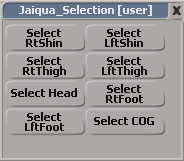There are many standard tools in Softimage that are not particularly designed for character animation, but can help your job of character animation go much more smoothly. Some of these tools are simple aids in making it easier to visualize or select elements, while others can solve major animation problems and change the way you work.
Both custom toolbars and the synoptic view allow you to set up whatever you like for character animation. They are typically used to make it easy to select and key character elements.
Synoptic views allow you to quickly access commands and data related to a specific object or model. Clicking on a hotspot in the image either opens another synoptic view or runs a script. For example, you can set up hotspots for selecting body parts or setting keys on different rig elements.
To see some synoptic pages, create a biped or quadruped rig (see Overview of Using the Predefined Rigs), then select any of its elements and press F3.
For more information on creating a synoptic view, see Synoptic Views [Customization].

|

|
Using custom parameters, you can create your own animation controls via expressions or linked parameters. You could control different rig elements or body parts via expressions using custom sliders, such as the movement of a hand and each of its fingers — see Custom and Proxy Parameters [Customization] for information on creating sliders.

Custom Property Editors with Proxy Parameters
Using proxy parameters, you can bring a number of parameters from different locations in Softimage "under one roof", creating your own property editor. Proxy parameters are clones of existing parameters: any changes you make to them has the same result as using the real thing. Having all pertinent parameters grouped together saves time because you only have to look in one place, allowing you to focus only on the parameters that matter.
For more information on proxy parameters, see Custom and Proxy Parameters [Customization].
Although these require a bit of work setting up, custom toolbars can save you a lot of time and effort in the long run. You can create a toolbar for a character, then add all sorts of custom buttons that run simple scripts to select different elements or open property editors.

For more information on custom buttons and toolbars, see Non–self-installing Script-based Custom Commands [Customization].